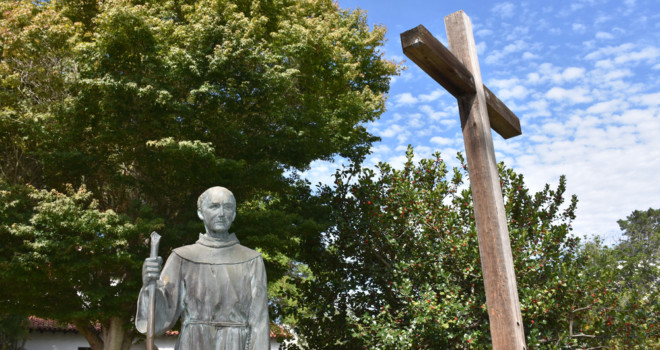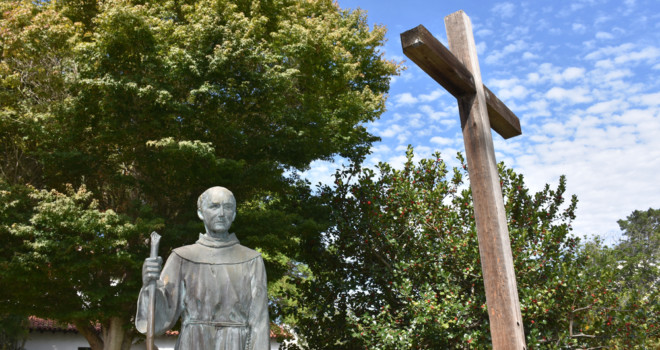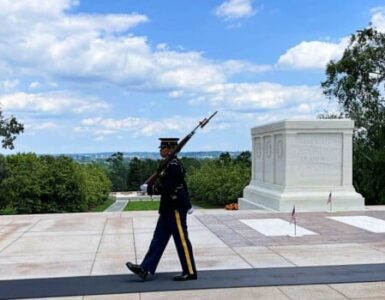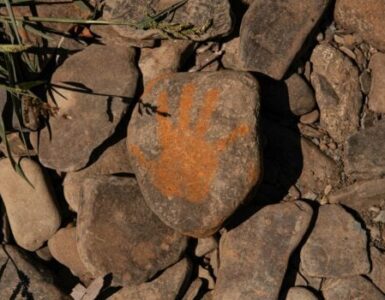The last year was a tough one, even for a Catholic saint. Saint Junípero Serra, the 18th-century Spanish priest—who Pope Francis called “the evangelizer of the west in the United States” and whose feast day is July 1—has been taking it in the chin. Vandalism of public statues of Junípero Serra have taken place by angry mobs and desecrated on Catholic church property—Mission Carmel, Old Mission Santa Barbara, Mission San Gabriel, and Mission San Rafael. The San Francisco Board of Education’s School Renaming Committee called him a “Colonizer and slaveowner” (see spreadsheet in Jan. 28 Mission Local article). No evidence was provided. They questioned no historians. What is being done in Los Angeles regarding public memory at least has representatives of all stakeholders (LA Times, Apr. 18).
Even elected officials are joining in. Assembly Bill 338 argues that the state is not big enough for acknowledging both Serra and California Indians with separate memorials. It wants to keep the Serra statue at the Capitol in storage and memorialize a California Indian in its place (I recommend Pablo Tac whose writings are the oldest from a California Indian, written while a seminarian in Rome). I guess those backing the bill forgot about Governor Newsom’s 2019 apology for the horror against California Indians with the backing of the state government. Maybe the Catholic Church can give Serra the moniker patron saint of millennials to help people rethink their thinking about the man who started the California missions. He has more in common with people today than one might think.
Millennials are defined by many attributes. This Gen X author would like to focus on some that are shared between the biggest generation in U.S. history and the Franciscan friar from Mallorca.
Junípero Serra: Patron Saint of Millennials?
Expressing the impatience Millennials may be known for, Serra time and again went storming into the office of men of power making demands for change, such as pleading with Pedro Fages, Military Governor of Alta California, 1770-1774 and 1782-1791, to have some of his soldiers stop abusing native women. Serra was a great supporter of women. Actually, one of his first acts after his arrival in New Spain was to honor a woman. On December 31, 1749, Saint Junípero Serra prayed at the Shrine of Our Lady of Guadalupe, north of Mexico City. The following day Serra officiated a Mass at the Shrine thanking God for safely getting him to New Spain. From there he walked to the College of San Fernando, a Franciscan missionary college, where he would learn how to work among the Indians.
Serra, too, saw great value in education. He was actually a professor at Lullian University in Mallorca before coming to the Americas.
Serra desired a strong sense of community, so much that he formed nine of them between San Francisco and San Diego. Hell or high water, he would do anything to build them. Saint Junípero Serra wrote on July 3, 1769 to his superior in Mexico City, Fr. Juan Andrés, from San Diego:
. . . those who come here as ministers should not imagine that they come for any other purpose than to put up with hardships for the love of God and the salvation of souls. . . . the almost complete lack of communication by sea makes it necessary that they endure, especially at the beginning, many and dire hardships. But to a willing heart all is sweet, amanti suave est.
Serra traveled thousands of miles during his lifetime, mostly with a bum leg. On the expedition to San Diego, he wrote on May 17, 1769: “I [Saint Junípero Serra] said Mass there, but I had much trouble in standing on my feet because the left one was much inflamed. For a year now, and more, I have been suffering considerably, and by now the swelling has reached halfway up my leg, which is covered with sores.” Unlike the Millennial who travels for leisure or adventure, Serra traveled to share the gospel message with total strangers.
Millennials like to be known for being authentic, as expressed by four-in-ten of them having tattoos. The penitent Serra expressed his authenticity through self-mortification.
Serra was compassionate, a virtue upheld by Millennials. Mission San Diego was attacked in November 1775 and three Spaniards killed. Serra would ask for leniency for the murderers. On December 15, 1775, Serra wrote to Viceroy Antonio María de Bucareli y Ursúa in Mexico City reminding him, “One of the most important requests I made . . . was that if the Indians, gentile or Christian, should kill me then they should be forgiven.”
During a time when Spaniards living in the Americas generally looked down on Indians, Serra traveled from Carmel to Mexico City demanding that the viceroy force the military to see the Indians as he saw them. On June 11, 1773, Saint Junípero Serra lobbied [Viceroy of New Spain] Antonio Maria de Bucareli y Ursua, Mexico City: “That at the first request of the Missionary Father . . . he [Commandant of the Presidio] should remove the soldier or soldiers who may have given bad example [to the Indians], especially in matters of incontinence [abuse], and that they be withdrawn to the presidio and another or others be sent in their place who are not known as indecorous and scandalous.”
Some values do not mesh, though. The entrepreneurial spirit of the Millennial would be foreign to Serra. He took a vow of poverty and did not own anything (actually, he would not change the clothes on his back until they literally fell apart).
The greatest recommendation I can make to those who want to make sense of the confounding accusations made against Serra is to read online (free) the Writings of Junípero Serra to learn what his vision was, motivations were, as well as his challenges, dreams, and successes. He will not disappoint, but inspire one to walk the via positiva.
✠















